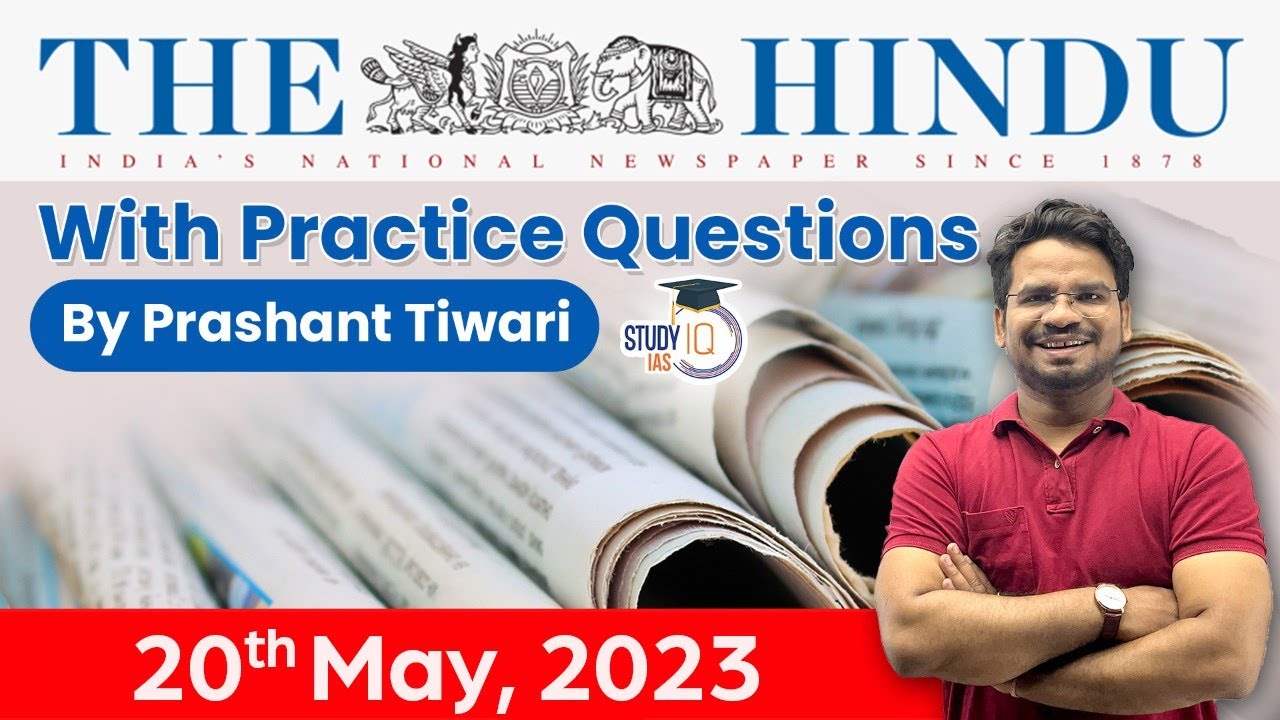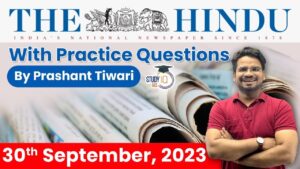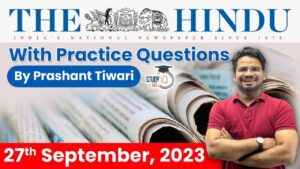The Hindu Newspaper Analysis for UPSC
‘
The Hindu Newspaper Analysis 18 May 2023
- The Reserve Bank of India (RBI) on Friday decided to withdraw ₹2,000 denomination banknotes from circulation in pursuance of its “Clean Note Policy”. However, the ₹2,000 notes will continue to be legal tender. A similar withdrawal of notes from circulation was undertaken in 2013-2014.
- Fiat money, also called fiat currency is a form of currency that is recognised as legal tender by the government but has no inherent value. It gains value only because people trust it due to the government order or law.
- Legal tender is any currency declared legal by a government. Many governments issue a fiat currency and then make it legal tender by setting it as the standard for repaying debt.
The Hindu Editorial Today

- The Union government on Friday brought an ordinance designating the Lieutenant-Governor (L-G) as the administrator of Delhi, with the final say on the postings and transfer of all bureaucrats serving the Delhi government.
- The ordinance, promulgated by President Droupadi Murmu, seeks to amend the Government of National Capital Territory of Delhi Act, 1991, and effectively negates the May 11 Supreme Court judgment that gave the Arvind Kejriwal-led Aam Aadmi Party (AAP) government the power to make laws and wield control over bureaucrats deputed to the Delhi government.
- The ordinance seeks to establish for the first time the National Capital Civil Service Authority (NCCSA), which will be headed by the Chief Minister of Delhi, with the Chief Secretary and Principal Home Secretary of Delhi as its other two members.
- “All matters required to be decided by the Authority shall be decided by majority of votes of the members present and voting,” read the ordinance, issued by the Union Law Ministry.
- The status of Delhi being a Union Territory under Schedule 1 of the Constitution but christened the ‘National Capital Territory’ under Article 239AA, engrafted by the Constitution (69th Amendment) Act.
- The 69th amendment to the Constitution of India inserted Article 239AA, which declared the Union Territory of Delhi to be administered by a L-G who works on aid and advice of the elected legislative assembly.
- the principles of federalism and democracy into Article 239AA, thereby finding a parliamentary intent to accord a sui generis (of its own kind) status in distinction from other Union Territories.
- Constitutional Provisions Regarding Ordinances
- The Constitution permits the central and state governments to make laws when Parliament (or the State Legislature) is not in session.
- The Indian Constitution, in Article 123, authorizes the executive to promulgate ordinances if certain conditions are satisfied.
- Ordinances may be promulgated only if at least one House of Parliament is not in session.
- President is satisfied that “immediate action” is necessary.
- The Constitution states that the ordinance will lapse at the end of six weeks from the time Parliament (or the State Legislature) next meets.
- Similar provisions also exist for state governments under article 213.

- Under the Nationally Determined Contributions (NDC), India has set a target of becoming a net-zero emission country by 2070. The country also aims to reduce its carbon emissions by 45% by 2030 by sourcing 50% of its energy from renewable sources.
- In its recent Union Budget, the Centre allocated ₹19,744 crore for the National Green Hydrogen Mission, which seeks to promote the development of green hydrogen production capacity of at least 5 MMT (Million Metric Tonnes) per annum, with an associated renewable energy capacity addition of about 125 gigawatts (GW) in the country by 2030.
- In addition, the policy aims to attract investment of over ₹8 lakh crore and create over 6 lakh jobs by 2030.

- Bhopal has become the first city in India to join the growing global movement on localisation of Sustainable Development Goals (SDGs) following the release of its Voluntary Local Review (VLR).
- In 2015, the 193 member-states of the United Nations adopted the 2030 Agenda for Sustainable Development, which consists of 17 Sustainable Development Goals and 169 targets as a plan of action for ‘people’, ‘the planet’, and ‘prosperity’.
- India’s Ministry of Statistics and Program Implementation (MoSPI) has published a National Indicator Framework (NIF) for the review and monitoring of the SDGs, which contextualises the UN’s Global Indicator Framework to represent India’s unique development journey.


- G-7 summit — India is a special invitee — Prime Minister Narendra Modi called India’s attendance “particularly meaningful” this year.
- Japan, as host, has taken a fairly tough position on Russia, with its envoy to India saying that the “message to Putin” must be that Russia will have to “pay” for its war in Ukraine.
- While all G-7 countries — the U.S., the U.K., Canada, France, Germany, Italy, Japan and the EU — are united in their efforts to sanction Russia further.
- The G20 or Group of Twenty is an intergovernmental forum comprising 19 countries and the European Union (EU)
- The G20 was founded in 1999 in response to several world economic crises
- Since 2008, it has convened at least once a year, with summits involving each member’s head of government or state, finance minister, foreign minister, and other high-ranking officials; the EU is represented by the European Commission and the European Central Bank


- Chief Justice of India D.Y. Chandrachud on Friday administered the oath of office to Justices Prashant Kumar Mishra and K.V. Viswanathan, bringing back the court to its full sanctioned strength of 34 judges.
- Justices Mishra and Viswanathan would replace Justices Dinesh Maheshwari and M.R. Shah, both of whom had retired earlier in May.
- Justice Viswanathan would be in line to be the 58th Chief Justice of India in August 2030, succeeding Justice J.B. Pardiwala as top judge. He is also only the ninth lawyer to be elevated directly to the Supreme Court Bench.
- Article 124 of the Constitution of India, 1950 establishes the Supreme Court of India and regulates the appointment of judges. The framers of the Constitution had fixed the strength of the Supreme Court to one Chief Justice and seven other judges. However, they left it to the future Parliaments to alter this composition.
- The Parliament enacted the two-section-long The Supreme Court (Number of Judges) Act, 1956 (‘Act’) and has amended this Act in six instances to fix the maximum ceiling for the number of judges. In 1956 the number was raised to 11. It was further amended to 14 in 1960, 18 in 1978, 26 in 1986 and 31 in 2009.
- In August 2019, in two days the Parliament amended the Act further to increase the number of judges to 33 Judges in addition to a Chief Justice.

- Though it is well known that ingesting high levels of arsenic from contaminated groundwater in India has been linked to a range of ailments, a recent peer-reviewed study suggests that even low levels of arsenic consumption may impact cognitive function in children, adolescents, and young adults.
- The research study, which is part of a bigger investigation into how a range of environmental and biological factors affect neurological and cognitive development in young people, also found that those exposed to arsenic had reduced grey matter (brain tissue that is vital to cognitive functions) and weaker connections within key regions of the brain that enable concentration, switching between tasks, and temporary storage of information.
- Arsenic exposure, previous studies have shown, is particularly harmful to the poor.
- Regions Affected: Most of the arsenic-affected habitations lie in the Ganga and Brahmaputra alluvial plains. i.e in Assam, Bihar, West Bengal, Punjab, and Uttar Pradesh (UP).
- Arsenic Poisoning
- Arsenic is naturally present at high levels in the earth crust and groundwater of a number of countries. It is highly toxic in its inorganic form.
- Contaminated water used for drinking, food preparation and irrigation of food crops poses the greatest threat to public health from arsenic.
- Long-term exposure to arsenic from drinking-water and food can cause cancer, skin disease, cardiovascular disease and diabetes.
- In early childhood exposure, it has been linked to negative impacts on cognitive development and increased deaths in young adults.
- According to the WHO’s guidelines for drinking water quality (2011), the permissible limit of Arsenic in groundwater is 0.01 mg per litre.
Q) Consider the following statements with reference to Nutrient Based Subsidy (NBS) scheme:
- Subsidy under the scheme is fixed after considering the benchmark international prices of finished fertilizers as well as raw materials.
- Subsidy is directly transferred to the bank account of the farmers.
Which of the above statements is/are correct?
- 1 only
- 2 only
- Both 1 and 2
- Neither 1 nor 2
पोषक तत्व आधारित सब्सिडी (एनबीएस) योजना के संदर्भ में निम्नलिखित कथनों पर विचार करें:
- तैयार उर्वरकों के साथ-साथ कच्चे माल की बेंचमार्क अंतरराष्ट्रीय कीमतों पर विचार करने के बाद योजना के तहत सब्सिडी तय की जाती है।
- सब्सिडी सीधे किसानों के बैंक खाते में ट्रांसफर की जाती है।
उपरोक्त कथनों में से कौन-सा/से सही है/हैं?
- केवल 1
- केवल 2
- 1 और 2 दोनों
- न तो 1 और न ही 2
Answer – 1
Nutrient Based Subsidy (NBS) rates has been confirmed for various nutrients i.e. Nitrogen (N), Phosphorus (P), Potash (K) and Sulphur (S) for Rabi Season 2022-23 and for Kharif Season, 2023 for Phosphatic and Potassic (P&K) fertilizers.
Nutrient Based Subsidy Scheme:
- The Subsidy on P&K fertilizers is governed by NBS Scheme under the Department of Fertilizers since 2010.
- Subsidy is fixed by an inter-ministerial committee taking into account the benchmark international prices of finished fertilisers as well as raw materials.
- The subsidy is given to registered P & K fertiliser manufacturers/importers which provides these fertilisers at subsidised rates to farmers.
- Benefits:
- It helps farmers in ensuring availability of essential nutrients at subsidized prices.
- It rationalizes the subsidy on P&K fertilizers, ensuring effective and efficient utilization of government resources.
Q) Consider the following statements with reference to International Organization for Migration:
- It is dedicated to promote humane and orderly migration for the benefit of all.
- India is not a member of International Organization for Migration.
Which of the above statements is/are correct?
- 1 only
- 2 only
- Both 1 and 2
- Neither 1 nor 2
प्रवासन के लिए अंतर्राष्ट्रीय संगठन के संदर्भ में निम्नलिखित कथनों पर विचार करें:
- यह सभी के लाभ के लिए मानवीय और व्यवस्थित प्रवासन को बढ़ावा देने के लिए समर्पित है।
- भारत प्रवासन के लिए अंतर्राष्ट्रीय संगठन का सदस्य नहीं है।
उपरोक्त कथनों में से कौन-सा/से सही है/हैं?
- केवल 1
- केवल 2
- 1 और 2 दोनों
- न तो 1 और न ही 2
Answer – 1
About International Organization for Migration:
- What it is? Established in 1951, IOM is the leading intergovernmental organization in the field of migration and works closely with governmental, intergovernmental and non-governmental partners.
- History: It was born in 1951 out of the chaos and displacement of Western Europe following the Second World War.
- Status: IOM was granted Permanent Observer status to the UN General Assembly in 1992, and a cooperation agreement between IOM and the UN was signed in 1996.
- Members: With 175 member states, a further 8 states holding observer status and offices in over 100 countries, IOM is dedicated to promoting humane and orderly migration for the benefit of all. It does so by providing services and advice to governments and migrants. India is a member of IOM.
- IOM works in the four broad areas of migration management:
- Migration and development
- Facilitating migration
- Regulating migration
- Forced migration.
Q) Consider the following statements regarding the Committee of Privileges:
- It consists of 22 members in Lok Sabha and 15 members in Rajya Sabha.
- In the Rajya Sabha, the deputy chairperson heads the committee of privileges.
Which of the above statements is/are correct?
- 1 only
- 2 only
- Both 1 and 2
- Neither 1 nor 2
विशेषाधिकार समिति के संबंध में निम्नलिखित कथनों पर विचार करें:
- इसमें लोकसभा के 22 सदस्य और राज्य सभा के 15 सदस्य होते हैं।
- राज्य सभा में, उपसभापति विशेषाधिकार समिति का प्रमुख होता है।
उपरोक्त कथनों में से कौन-सा/से सही है/हैं?
- केवल 1
- केवल 2
- 1 और 2 दोनों
- न तो 1 और न ही 2
Answer – 2
About Committee of Privileges:
- This committee consists of 15 members in Lok Sabha ( 10 in case of Rajya Sabha) nominated by the Speaker (Chairman in case of Rajya Sabha).
- In the Rajya Sabha, the deputy chairperson heads the committee of privileges.
- Powers and Functions:
- The committee examines every question involving a breach of privilege of the House or of the members or of any Committee thereof referred to it by the House or by the Speaker/Chairman.
- It also determines with reference to the facts of each case whether a breach of privilege is involved and makes suitable recommendations in its report.
- It also states the procedure to be followed by the House in giving effect to its recommendations.
- When a question of privilege is referred to the Committee by the House, the report of the Committee is presented to the House by the Chairman or, in his absence, by any member of the Committee.
- Where a question of privilege is referred to the Committee by the Speaker, the report of the Committee is presented to the Speaker who may pass final orders thereon or direct that it be laid on the Table of the House.
- The Speaker/Chairman may refer to the Committee any petition regarding the disqualification of a member on the ground of defection for making a preliminary inquiry and submitting a report to him.
- The procedure to be followed by the Committee in these cases is so far as may be the same as in applicable to questions of breach of privilege.
Q) Consider the following statements with reference to the Sanchar Saathi portal:
- It allows mobile phone users to block the stolen or lost mobile phones.
- It has been developed by the Department of Tele-communications (DoT) to prevent banking frauds.
Which of the above statements is/are correct?
- 1 only
- 2 only
- Both 1 and 2
- Neither 1 nor 2
संचार साथी पोर्टल के संदर्भ में निम्नलिखित कथनों पर विचार करें:
- यह मोबाइल फोन उपयोगकर्ताओं को चोरी या गुम हुए मोबाइल फोन को ब्लॉक करने की अनुमति देता है।
- इसे बैंकिंग धोखाधड़ी को रोकने के लिए दूरसंचार विभाग (DoT) द्वारा विकसित किया गया है।
उपरोक्त कथनों में से कौन-सा/से सही है/हैं?
- केवल 1
- केवल 2
- 1 और 2 दोनों
- न तो 1 और न ही 2
Answer – 3
About Sanchar Saathi portal:
- The portal aims to provide various reforms and services related to mobile connections and telecommunications.
- It has been developed by C-DoT under the Department of Tele-communications (DoT) to prevent frauds such as identity theft, forged KYC, banking frauds etc.
- The portal allows mobile phone users to:
- Check the connections registered on their names,
- Report fraudulent or unrequired connections,
- Block the mobile phones which are stolen/lost,
- Check IMEI genuineness before buying a mobile phone,
- The three reforms are being introduced as part of the portal’s framework:
- CEIR (Central Equipment Identity Register): It enables the tracking and blocking of lost or stolen phones anywhere in the country.
- Know your mobile connections: It allows users to check the number of mobile connections issued in their name by logging in using their mobile number. This feature helps identify any unauthorized or unwanted connections, which can be blocked immediately.
Q) Consider the following statements regarding the Khasi people:
- They form the largest community in the state of Meghalaya.
- They are divided into several clans and follows a matrilineal society.
Which of the above statements is/are correct?
- 1 only
- 2 only
- Both 1 and 2
- Neither 1 nor 2
खासी लोगों के बारे में निम्नलिखित कथनों पर विचार करें:
- वे मेघालय राज्य में सबसे बड़ा समुदाय बनाते हैं।
- वे कई कुलों में विभाजित हैं और एक मातृसत्तात्मक समाज का अनुसरण करते हैं।
उपरोक्त कथनों में से कौन-सा/से सही है/हैं?
- केवल 1
- केवल 2
- 1 और 2 दोनों
- न तो 1 और न ही 2
Answer – 3
About Khasi people:
- The Khasi people are an indigenous ethnic group of Meghalaya in north-eastern India with a significant population in the bordering state of Assam, and in certain parts of Bangladesh.
- They inhabit the eastern part of Meghalaya, in the Khasi and Jaintia Hills. Khasis residing in Jaintia hills are now better known as Jaintias. They are also called Pnars.
- The Khasis occupying the northern lowlands and foothills are generally called Bhois. Those who live in the southern tracts are termed Wars.
- The Khasi people form the majority of the population of the eastern part of Meghalaya, and is the state’s largest community, with around 48% of the population of Meghalaya.


 The Hindu Newspaper Analysis 6 October 2...
The Hindu Newspaper Analysis 6 October 2...
 The Hindu Newspaper Analysis 30 Septembe...
The Hindu Newspaper Analysis 30 Septembe...
 The Hindu Newspaper Analysis 27 Septembe...
The Hindu Newspaper Analysis 27 Septembe...





















